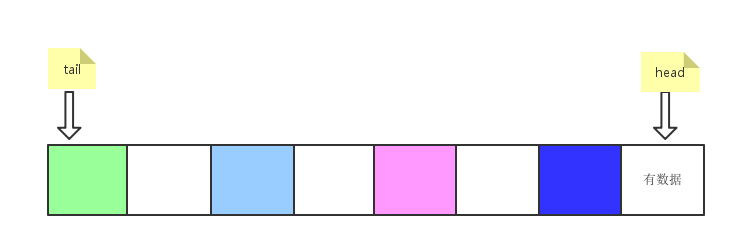ArrayDeque源码解析
2016-07-02 21:39
351 查看
ArrayDeque是一个双端队列,它是线程不安全的,不能插入null元素,当使用栈时比Stack要快,当使用队列时比LinkedList要快。
先初始化一个一定大小的数组,大小是2的n次方,接下来看下添加的源码。
head = (head - 1) & (elements.length - 1),当第一次添加时head变成数组的最后一个元素,以后每次减一。
添加一个元素后的图如下

接下来看扩容的源码
将老数组复制到新的数组中,
接下来看addLast
pollFirst()返回第一个元素,并删除
其它的几个增删就和上面的几个方法类似,我就不再写了。
先初始化一个一定大小的数组,大小是2的n次方,接下来看下添加的源码。
public void addFirst(E e) {
if (e == null)
throw new NullPointerException();
elements[head = (head - 1) & (elements.length - 1)] = e;
//head ,和tail开始都是0,当下次再相同时,说明数组满了,需要扩展了
if (head == tail)
doubleCapacity();
}head = (head - 1) & (elements.length - 1),当第一次添加时head变成数组的最后一个元素,以后每次减一。
添加一个元素后的图如下

接下来看扩容的源码
private void doubleCapacity() {
assert head == tail;
int p = head;
int n = elements.length;
int r = n - p; // number of elements to the right of p
int newCapacity = n << 1;
if (newCapacity < 0)
throw new IllegalStateException("Sorry, deque too big");
Object[] a = new Object[newCapacity];
System.arraycopy(elements, p, a, 0, r);
System.arraycopy(elements, 0, a, r, p);
elements = (E[])a;
head = 0;
tail = n;
}将老数组复制到新的数组中,
接下来看addLast
public void addLast(E e) {
if (e == null)
throw new NullPointerException();
elements[tail] = e;
//保证tail正向增长
if ( (tail = (tail + 1) & (elements.length - 1)) == head)
doubleCapacity();
}pollFirst()返回第一个元素,并删除
public E pollFirst() {
int h = head;
E result = elements[h]; // Element is null if deque empty
if (result == null)
return null;
elements[h] = null; // Must null out slot
//将head增长一个,如果没元素就是0
head = (h + 1) & (elements.length - 1);
return result;
}其它的几个增删就和上面的几个方法类似,我就不再写了。
说说ArrayDeque和Stack和LindedList的对比
Stack是继承的vector里面很多方法都是同步的,所以比ArrayDeque慢,而且有很多vector的方法。LindedList作为队列在增加和删除的时候需要移动指针,需要再开辟空间。ArrayDeque很多时候不需要从扩大,这也是ArrayDeque性能较好的原因吧。相关文章推荐
- 从源码安装Mysql/Percona 5.5
- 浅析Ruby的源代码布局及其编程风格
- asp.net 抓取网页源码三种实现方法
- JS小游戏之仙剑翻牌源码详解
- JS小游戏之宇宙战机源码详解
- jQuery源码分析之jQuery中的循环技巧详解
- 本人自用的global.js库源码分享
- java中原码、反码与补码的问题分析
- ASP.NET使用HttpWebRequest读取远程网页源代码
- PHP网页游戏学习之Xnova(ogame)源码解读(六)
- C#获取网页HTML源码实例
- PHP网页游戏学习之Xnova(ogame)源码解读(八)
- PHP网页游戏学习之Xnova(ogame)源码解读(四)
- 深入理解PHP之源码目录结构与功能说明
- JS小游戏之极速快跑源码详解
- JS小游戏之象棋暗棋源码详解
- android源码探索之定制android关机界面的方法
- 基于Android设计模式之--SDK源码之策略模式的详解
- Android游戏源码分享之2048
- C语言借助EasyX实现的生命游戏源码
